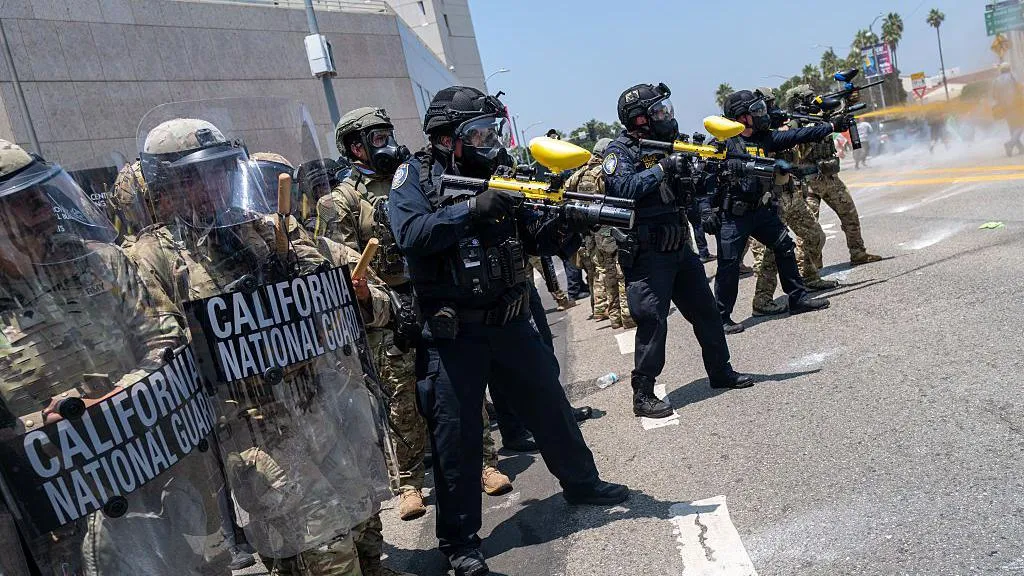In the early hours of Sunday, June 8, 2025, a small parking lot near a Home Depot store in Paramount, a city in Los Angeles County with a predominantly Hispanic population, became the epicenter of a volatile protest sparked by rumors of an immigration enforcement raid. This incident, while grounded in misinformation, has escalated tensions surrounding U.S. immigration policies and President Donald Trump’s ongoing efforts to crack down on undocumented migrants. What began as a group of day laborers seeking work in a quiet commercial parking lot quickly turned into an explosive flashpoint of fear, rage, and confusion, leaving the community fractured and searching for answers.
The incident unfolded in the parking lot of Home Depot, where day laborers, many of whom are undocumented, typically gather to seek work from contractors and homeowners. The parking lot outside this Home Depot in Paramount has long been a hub for these workers, many of whom rely on the goodwill of shoppers looking for help with home improvement projects. However, on this particular Saturday, a sense of unease began to spread after reports surfaced of immigration enforcement vehicles in the area. These reports led to widespread rumors that Immigration and Customs Enforcement (ICE) had conducted a raid, detaining several individuals. The fears were quickly compounded by misinformation suggesting that arrests had been made and that a full-scale operation had taken place.
Juan, a young man who had been waiting in the parking lot with friends to find work, described the scene: “No one really knows what happened. Everyone is afraid.” As the rumors swirled, the community’s anxieties mounted, and a peaceful gathering of workers outside the hardware store soon turned into a full-fledged protest. By the evening, it was no longer just about work or immigration enforcement—it became a fight for dignity, safety, and the right to exist without fear. What started as peaceful demonstrations turned violent, with protesters hurling rocks and Molotov cocktails at police, who responded with pepper spray, rubber bullets, and smoke bombs to regain control.
The protests spread quickly, with confrontations breaking out in various parts of Los Angeles as people rallied against the administration’s policies and the fear that now gripped their communities. Protesters waved Mexican flags and held banners denouncing ICE and the administration’s stance on immigration. The riots soon reached a breaking point, with looting and a car set on fire. Authorities, struggling to contain the chaos, called in reinforcements, and for the first time, the California National Guard was deployed to the streets of Los Angeles at the behest of President Trump. This marked an escalation of the already tense situation, as soldiers in Humvees were stationed near protest hotspots to maintain order. In the heart of the unrest, National Guard troops squared off with protesters, creating a visual clash of military might against public dissent.
The federal government, meanwhile, had been focusing its attention on the growing number of undocumented migrants across the country, particularly in California. The Department of Homeland Security (DHS) later confirmed that several arrests had taken place in the region, with a focus on those with prior criminal histories, including drug trafficking and assault charges. DHS also emphasized that the reports of a raid at Home Depot were false, calling the situation a case of misinformation that fueled the protests.
The rumors surrounding the supposed ICE raid at Home Depot had taken on a life of their own, and within hours, social media platforms like Reddit were filled with posts from concerned locals. One user wrote, “What’s going on at De Neve? There are so many rumors floating around, and people deserve facts, not fear.” The online discussions quickly turned into a mixture of disbelief, concern, and support for the immigrant community, as residents expressed their shock over the events unfolding in their own backyards.
But as the protests continued throughout the weekend, the question remained: How did this happen? How did a mere rumor about an immigration enforcement operation become the catalyst for what federal authorities described as riots throughout the city?
The fact that the protests and unrest were fueled by misinformation and a lack of clear communication from authorities exacerbated the anger already felt by many in Los Angeles. In particular, the city’s Latino community, which makes up a significant portion of the population, has been directly affected by the Trump administration’s hardline stance on immigration. In many ways, Los Angeles has long served as a sanctuary for undocumented immigrants, and the administration’s aggressive policies have only deepened the sense of fear and insecurity in these communities.
Maria Gutierrez, a protester in Paramount, expressed her anger and frustration with the situation, stating, “It was time to stand up. These are my people.” Gutierrez, who was born in Mexico and has lived in Los Angeles since she was a child, explained that the protests felt like a breaking point for the immigrant community. “Everyone has family or knows someone who doesn’t have papers,” she added, noting that many in her community are directly impacted by the uncertainty created by federal immigration enforcement.
The day after the protests, community members gathered in the Chapel of Change church, less than a block away from where the protests had erupted, to reflect on the events. Dora Sanchez, a local resident, expressed disbelief at the shocking scenes that had unfolded the night before. She spoke of how the neighborhood had long been a place of unity, with neighbors watching out for one another and offering support. Now, it felt as though that sense of community was under threat.
Los Angeles, which has long been a majority-minority city, is home to a significant number of Mexican immigrants who have contributed immensely to the city’s culture and economy. The protests and violence that erupted over the weekend highlighted the deep fractures within the city, where the debate over immigration reform continues to divide public opinion. For many, the arrival of the National Guard was a clear indication that the federal government’s stance on immigration had reached new levels of intensity.
President Trump’s use of federal powers to deploy the National Guard to Los Angeles has sparked widespread debate, with some viewing it as necessary to maintain order, while others see it as an authoritarian move to quell dissent. The National Guard’s presence, with their military vehicles and armed patrols, only added to the sense of militarization and fear that many in the community already felt. Trump’s statements following the deployment reflected his administration’s position: “We are dealing with violent people, and they’re not going to get away with it,” he said as he boarded Air Force One, standing firm in his stance on law and order.
As the protests subsided, the damage to local businesses, the emotional toll on the community, and the ongoing tension left behind were undeniable. But in the aftermath, many in Los Angeles are calling for a more compassionate approach to the issue of immigration. “We need more community, more care,” one protester wrote. There is a growing demand for better communication from authorities, more resources for undocumented immigrants, and an overall culture of compassion to replace the fear and division that have plagued the city in recent years.
In the end, the protests in Los Angeles were a stark reminder of the challenges faced by immigrant communities in the U.S., and the deep divisions that have emerged over immigration policy. While the false reports that triggered the unrest were based on misinformation, they have highlighted the broader need for meaningful dialogue, reform, and empathy in the ongoing debate over immigration in America. Until then, the city of Los Angeles, and the country as a whole, will continue to grapple with the consequences of an immigration system that many argue is in desperate need of change.




